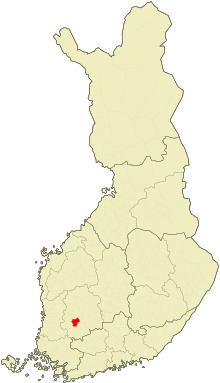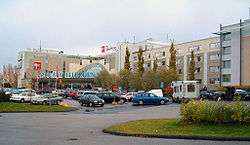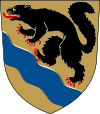Nokia, Finland
| Nokia | ||
|---|---|---|
| Town | ||
| Nokian kaupunki | ||
 Nokia church (designed by C. L. Engel) in December 2005 | ||
| ||
 Location of Nokia in Finland | ||
| Coordinates: 61°29′N 023°31′E / 61.483°N 23.517°ECoordinates: 61°29′N 023°31′E / 61.483°N 23.517°E | ||
| Country |
| |
| Region | Pirkanmaa | |
| Sub-region | Tampere sub-region | |
| Charter | 1922 | |
| Market town | 1937 | |
| City rights | 1977 | |
| Government | ||
| • Town manager | Markku Rahikkala | |
| Area (2018-01-01)[1] | ||
| • Total | 347.76 km2 (134.27 sq mi) | |
| • Land | 288.18 km2 (111.27 sq mi) | |
| • Water | 59.58 km2 (23.00 sq mi) | |
| Area rank | 237th largest in Finland | |
| Population (2017-08-31)[2] | ||
| • Total | 33,288 | |
| • Rank | 33rd largest in Finland | |
| • Density | 115.51/km2 (299.2/sq mi) | |
| • Demonym | Nokialainen (Finnish) | |
| Population by native language[3] | ||
| • Finnish | 98% (official) | |
| • Swedish | 0.3% | |
| • Others | 1.6% | |
| Population by age[4] | ||
| • 0 to 14 | 19.6% | |
| • 15 to 64 | 65.9% | |
| • 65 or older | 14.5% | |
| Time zone | UTC+2 (EET) | |
| • Summer (DST) | UTC+3 (EEST) | |
| Municipal tax rate[5] | 19.75% | |
| Website | www.nokiankaupunki.fi | |
Nokia (Finnish pronunciation: [ˈnokiɑ]) is a town and a municipality on the banks of the Nokianvirta River (Kokemäenjoki) in the region of Pirkanmaa, some 15 kilometres (9 mi) west of Tampere. As of 31 August 2017 it has a population of 33,288.
History
The origin of the name Nokia is obscure. In modern Finnish, noki means soot and nokia is its inflected plural, although this form of the word is rarely if ever used. The most common theory claims the name actually originates from the archaic Finnish word nois (pl. nokia) or nokinäätä ("soot marten"), meaning sable.[6] After sable was hunted to extinction in Finland, the word was applied to any dark-coated fur animal, such as the marten, which are found in the area to this day. The sable is enshrined on the Nokia coat of arms. However, later research has appeared to indicate that sables never inhabited Finland in the first place, and the name nois may actually refer to the beaver.[7]
The first literary reference to Nokia is in a 1505 document in connection with the Nokia Manor.
Nokia was the setting of one of the largest battles in the Club War, a 1596 peasant uprising against feudal lords. The peasants, armed with clubs, took up residence in Nokia Manor and won several skirmishes against the feudal cavalry, but were decisively defeated by Klaus Fleming on 1–2 January 1597. Thousands of clubmen were slain and their leader Jaakko Ilkka, who had fled, was captured a few weeks later and executed. The Club War was the last major peasant revolt in Finland, and it permanently consolidated the hold of the nation state. Much later, in the Finnish Civil War (1918), Nokia (along with neighboring Tampere) was a Socialist stronghold and saw some combat.
Nokia used to reach out to the current heart of Tampere, with the Pispala area a part of Nokia's Suur-Pirkkala area. Suur-Pirkkala was eventually split into Pohjois- and Eteläis-Pirkkala (Northern and Southern). In 1938 Pohjois-Pirkkala was renamed as Nokia and Southern Pirkkala restored its original Pirkkala name. Nokia was designated as a city in 1977.
Industrial history

The eponymous telecommunications giant Nokia was founded by Fredrik Idestam in 1865 as a pulp mill. The Finnish Rubber Works Ltd (Suomen Gummitehdas Oy) (founded 1898) set up a factory in Nokia in 1904. These two companies and the Cable Company Ltd (Kaapelitehdas Oy) amalgamated in 1967 forming Nokia Corporation. Different branches of this conglomerate were split into several companies or sold off around 1990. The rubber works still operates in Nokia as Nokian Tyres and the paper mill as Georgia-Pacific Finland Oy.
As of 2008, the telecommunication company Nokia no longer has any operations in the city of Nokia. Despite the company having been founded in Nokia, the headquarters were moved to Espoo, and the main factories are in Salo, both nearly 200 kilometres south of Nokia. The only current presence of the company in the city is the Nokia mansion, which is sometimes used for private parties for the company's executive staff. The city has repeatedly been asked to commemorate the company it gave birth to, but it has always declined, on the grounds that mobile phones were never produced there.[8]
Nokia does have engineering and design facilities 15 kilometers away in nearby Tampere.
Present
Today's Nokia is famous for its spa, factory shops, waterways, and events. Nokia also enjoys good road and air connections. From a religious perspective, Nokia is best known for the charismatic Nokia Revival which began in 1990, and continues to the present through the work of Markku Koivisto and Nokia Missio, which practically died since the founder had to leave the mission, because of inappropriate sexual behavior.
Notable natives
- Tapio Rautavaara – athlete, musician, actor
- Kari Peitsamo – musician
- Anssi Salmela – ice hockey player
- Juuso Valimaki – ice hockey player
Statistics
| SES | Employers |
|---|---|
| Entrepreneurs altogether | 954 |
| Higher officials | 1322 |
| Lower officials | 3137 |
| Farm workers | 49 |
| Industrial workers | 2731 |
| Other production workers | 802 |
Twin towns – sister cities
Nokia is twinned with:
See also
References
- ↑ "Area of Finnish Municipalities 1.1.2018" (PDF). National Land Survey of Finland. Retrieved 30 January 2018.
- ↑ "Ennakkoväkiluku sukupuolen mukaan alueittain, elokuu 2017" (in Finnish). Statistics Finland. Retrieved 18 October 2017.
- ↑ "Population according to language and the number of foreigners and land area km2 by area as of 31 December 2008". Statistics Finland's PX-Web databases. Statistics Finland. Retrieved 29 March 2009.
- ↑ "Population according to age and gender by area as of 31 December 2008". Statistics Finland's PX-Web databases. Statistics Finland. Retrieved 28 April 2009.
- ↑ "List of municipal and parish tax rates in 2011". Tax Administration of Finland. 29 November 2010. Retrieved 13 March 2011.
- ↑ Matti Helminen (18 February 2008). "Kuuluiko soopeli Suomen eläimistöön" (in Finnish). Archived from the original on 13 July 2009.
- ↑ Larry Huldén: Oliko soopeli karjalainen turkiseläin? Viipurin läänin historia II. Jyväskylä 2004 (in Finnish)
- ↑ Aamulehti weekend supplement, August 18–19, 2007
- ↑ The information is based on the 1995 census. Statistics Finland, September 25, 2006
External links
| Wikimedia Commons has media related to Nokia, Finland. |
- Town of Nokia – Official Website


